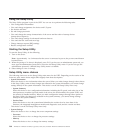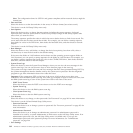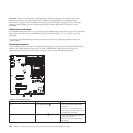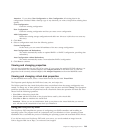
Table 24. RAID configuration utilities (continued)
RAID configuration utility Description Location
Where to find more
information
MegaRAID BIOS
Configuration Utility
(WebBIOS)
For:
v IBM ServeRAID-BR10il
SAS/SATA Controller
v IBM ServeRAID-MR10i
SAS/SATA Controller
v IBM ServeRAID-M1015
SAS/SATA controller
In system firmware. To
access:
v Use UEFI Setup Utility.
v PressCtrl+Hatthe
WebBIOS prompt
during startup.
“Using the WebBIOS
utility” on page 208
LSI Configuration Utility For:
v IBM ServeRAID-BR10il
SAS/SATA Controller
v IBM ServeRAID-MR10i
SAS/SATA Controller
v IBM ServeRAID-M1015
SAS/SATA controller
In system firmware. To
access:
v Use UEFI Setup Utility.
v PressCtrl+CattheLSI
prompt during startup.
“Using LSI Configuration
Utility program”
Using LSI Configuration Utility program
Use the LSI Configuration Utility program to configure and manage redundant array of independent
disks (RAID) arrays. Be sure to use this program as described in this document.
v Use the LSI Configuration Utility program to perform the following tasks:
– Perform a low-level format on a hard disk drive
– Create an array of hard disk drives with or without a hot-spare drive
– Set protocol parameters on hard disk drives
The integrated SAS/SATA controller with RAID capabilities supports RAID arrays. You can use the LSI
Configuration Utility program to configure RAID 1 (IM), RAID 1E (IME), and RAID 0 (IS) for a single
pair of attached devices. If you install a different type of RAID controller, follow the instructions in the
documentation that comes with the adapter to view or change settings for attached devices.
When you are using the LSI Configuration Utility program to configure and manage arrays, consider the
following information:
v The integrated SAS/SATA controller with RAID capabilities supports the following features:
– Integrated Mirroring (IM) with hot-spare support (also known as RAID 1)
Use this option to create an integrated array of two disks plus up to two optional hot spares. All
data on the primary disk can be migrated.
– Integrated Mirroring Enhanced (IME) with hot-spare support (also known as RAID 1E)
Use this option to create an integrated mirror enhanced array of three to eight disks, including up to
two optional hot spares. All data on the array disks will be deleted.
– Integrated Striping (IS) (also known as RAID 0)
Use this option to create an integrated striping array of two to eight disks. All data on the array
disks will be deleted.
v Hard disk drive capacities affect how you create arrays. The drives in an array can have different
capacities, but the RAID controller treats them as if they all have the capacity of the smallest hard disk
drive.
v If you use an integrated SAS/SATA controller with RAID capabilities to configure a RAID 1 (mirrored)
array after you have installed the operating system, you will lose access to any data or applications
that were previously stored on the secondary drive of the mirrored pair.
206 ThinkServer ThinkServer RS210, Types 6531, 6532, 6533, and 6534: Hardware Maintenance Manual


















